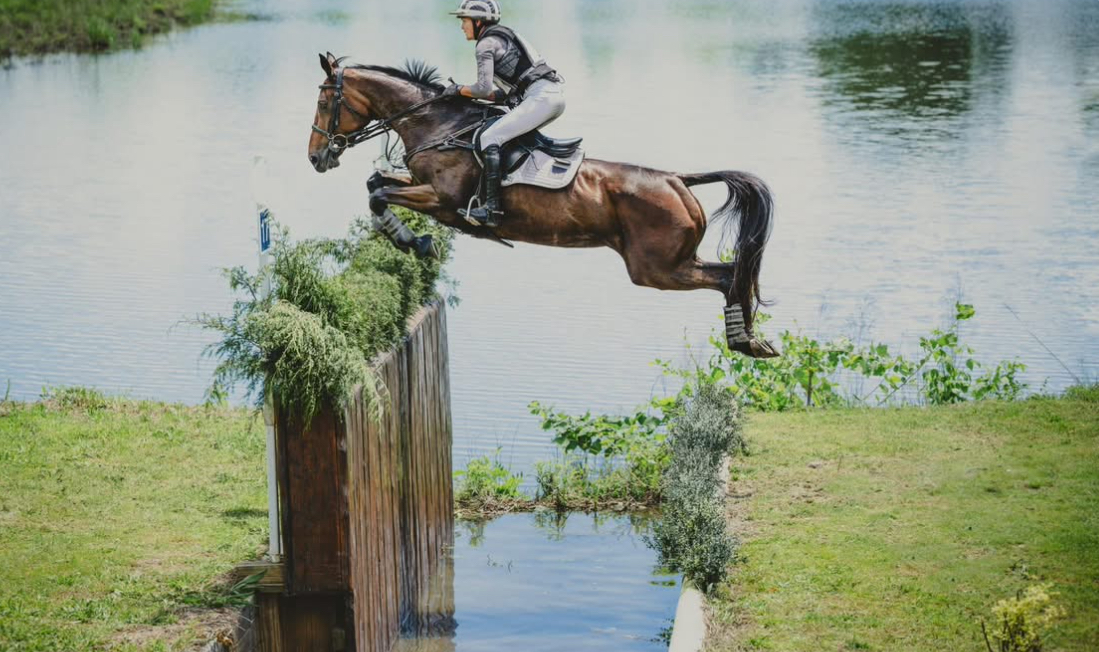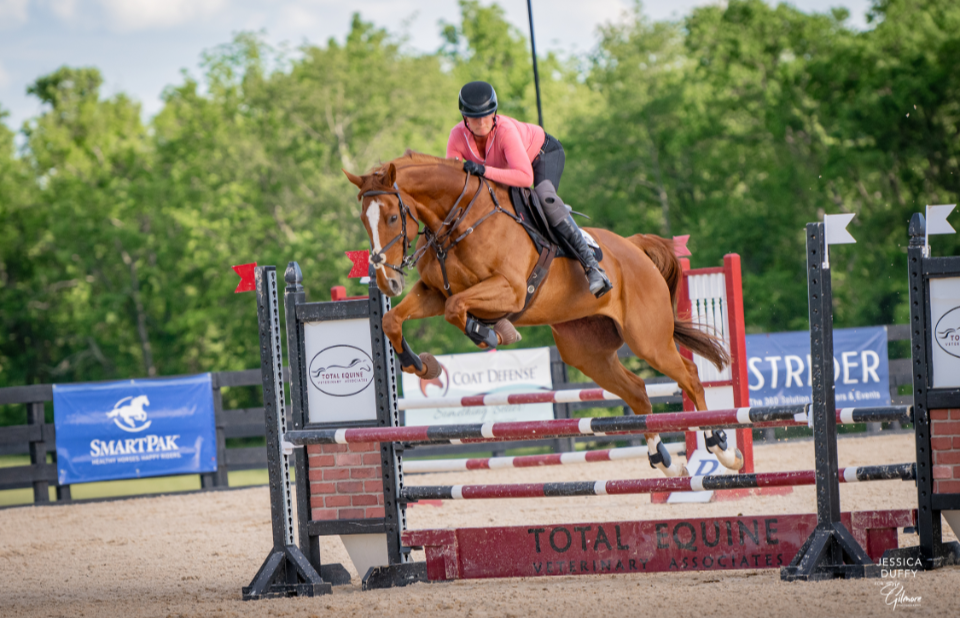
Leggings and gloves by Aztec Diamond Equestrian. Photo by Dan Powell.
Christmas came a little early for me when I opened up a package from UK-based equestrian apparel brand Aztec Diamond Equestrian with a couple items test out and review. While Aztec Diamond is a familiar name across the pond, I haven’t seen much of this streetwear-meets-contemporary equestrian brand here in the US so I was certainly curious to give them a try. A functional, stylish, and affordable woman-owned clothing brand that’s also doing their part to combat fast fashion and promote sustainability? Yes, please!
Before I get to reviewing my items, I’d like to quickly introduce you to the brand because I think their story is just as cool as their products. Aztec Diamond — named for the founder’s first horse — is the culmination of a childhood dream for CEO Jordan McCabe, who, upon falling in love with show jumping, identified a need in the industry for fashionable yet affordable apparel and equipment that maintained the flexibility and functionality needed for equestrian sports.
Starting an equestrian fashion line was a dream of Jordan’s from an early age and whatever free time she had left between grade school, barn work, and riding lessons was spent sketching designs for riding clothes complete with matching outfits for her pony as well. While still a teenager, Jordan was able to make her dreams a reality and launched Aztec Diamond Equestrian in 2014 without any extensive experience in business or textile manufacturing. Since then, the company’s minimalist yet highly functional designs — which can easily crossover from the barn to the gym — have become a mainstay brand in Europe and Jordan was named to the Forbes 30 Under 30 list for Retail and Commerce last year. Pretty cool, huh?
Full Seat Icon Riding Leggings
One of the products that Aztec Diamond introduced when they launched were riding leggings/ tights, which in 2014 were not a prevalent part of equestrian fashion scene. Today, they’re a staple of many riders’ wardrobes and there is a large selection available in tack stores and catalogs around the world. Instead of fading into oblivion after the industry-wide boom in riding tights, Jordan has continued to refine and redesign Aztec Diamond’s flagship product on stay on top of the game.
When it comes to riding tights there are two majorly important aspects to people — thickness and stickiness — so let’s talk about those right off the bat.
In horse blanketing terms, I’d call the Icon Riding Leggings a mid-weight. They’re made out of a slightly thicker material than I’ve encountered in any other riding tights and they’ve been quite comfortable as I’ve ridden in them during the late fall and early season winter.
They’re also thick enough that they aren’t at all see though (yes, they pass the “squat test” and also yes, I’ve been working out in these leggings in addition to riding in them) yet still light enough that they’re breathable and easy to move around in. Oh, and that awesome thicker material is primarily made up of polyester from recycled plastics so you can feel awesome about choosing a more earth-friendly option while looking awesome as well.
Now about the stickiness. Everyone has their own (usually strong) preferences regarding knee patch versus full seat and silicone versus suede. Me? I’m pretty firmly in the full seat camp, but I lean more towards a suede full seat instead of silicone. While I like a little bit of extra friction against the saddle, I don’t love an ultra-sticky seat that makes it feel like my tush is following the movement of the canter but my pants are not.
Since I’m usually a full seat person, I opted to try the full seat version of these leggings (they do come in knee patch as well in case full seat isn’t your jam!) and I was delighted to find that the silicone on these leggings is really my perfect level of grippiness. I wouldn’t say they are “sticky” at all actually, yet they still provide the right amount of friction to keep me from feeling like I’m siding around in the saddle.
I’m also delighted in the durability that the silicone grips have shown so far. On other silicone full seat tights that I’ve ridden in, I’ve found bits of the silicone flaked off and dotting the seat of my saddle at the end of a ride. Not so with these Aztec Diamond leggings.
By whatever means these silicone grips are attached to the fabric, they’re on there good and haven’t shown any sides of budging — not even after I’ve been incorrectly washing and drying them because I’m really bad at reading and following the care instructions on clothing. It is recommended to wash them inside out and to air dry them — I have done exactly the opposite of those things for several weeks, yet the leggings are still looking brand new. But do as I say and not as I absentmindedly do because after all, they’ll probably keep looking brand new for even longer if you actually follow the recommended care.

Trust me, my phone is not going anywhere! Leggings and gloves by Aztec Diamond Equestrian. Photo by Dan Powell.
Now let’s talk fit. Depending on the brand, I am currently wearing a size 6 or 8 in normal-people pants and a size 32 in most breeches, and after looking at the size chart and reading on the Aztec Diamond website that their leggings tend to fit generously, I ordered a size small and hoped for the best.
Upon unwrapping the leggings and pulling them out of their compostable packing bag they looked almost startlingly tiny, but when I pulled them on they gave me major Sisterhood of the Traveling Pants vibes and looked quite sleek. I think the curved seams are flattering and the higher cut waist sits in a great spot on me. Plus, I think the slightly thicker material prevents the wearer from looking too much like a sausage casing. So if that’s been your fear that has stopped you from trying riding tights in the past, give these ones a shot first and see if they change your mind.
The Icon Riding Leggings also have a number of other thoughtful design elements that I haven’t seen anywhere else and would be remiss not to mention:
- The reinforced waistband has a wide panel on the inside which helps to create a smooth silhouette for the wearer and a little bit of silicone on the inside of that hidden band helps to keep the leggings from riding down.
- The phone pocket, which sits on the right thigh, extends all the way down to the knee so there’s plenty of room for cookies in there, but a silicone grip on the inside of the pocket (stickier than the grips on the seat) keeps your phone from moving the slightest bit while you walk, trot, canter and jump — neither falling out of the pocket nor sinking to the bottom.
- The panel of fabric that sits over the hip bone (above the pocket)is made of a different textile than the rest of the leggings, bringing another dimension to the cool look of these tights and helping to hug the curves of the wear in the right ways.
With the luxury brand look of these leggings and all of the features that they tout, you might be thinking that they’re a bank-breaker. Nope. The price point (£50/£60 for knee patch and full seat respectively, which converts to roughly $66-79 USD) is one of the lowest you’ll find for riding leggings. With shipping from the UK, you might end up spending a comparable amount to leggings from some of the major US retailers, but it’s worth it if you’re happier with the end product. I am.
Soft Shell Riding Gloves
Get your hands on a pair of these Soft Shell Riding Gloves, because I have been wearing them non-stop whenever I’m outside. Riding, walking the dog, stacking hay, mucking stalls, drinking a cold can of cider while hand walking my pony — these gloves are good for it all and they’ve kept my hands warm and dry in the current early winter weather.
I have to admit though that while I have been loving wearing these gloves around the barn, they’re not my favorite for riding. While the soft shell fabric is relatively non-bulky, especially for a winter gloves, they don’t offer the level of grip that I prefer in a pair of riding gloves — especially if I’m riding my dressage bridle with flat, plain leather reins. If you primarily ride with rubber reins or reins with substantial stoppers, then you shouldn’t have a problem.
Aside from the warmth that these gloves provide, I think my favorite feature is the touchscreen compatible material on the index finger and thumbs. I am honestly amazed that they work so well, even with the thicker soft shell material. I love the zippers on the wrist of the glove as well, which help to provide a tighter fit and keep out the cold.

Photo courtesy fo Aztec Diamond Equestrian.
Other Notes on Sizing:
I was originally also supposed to review a pair of AD Performance Breeches and an Icon Base Layer as well, but I unfortunately ordered the wrong sizes. For the breeches, I’m certain that I just flubbed the conversion from UK to US sizes so make sure you do your research or ask the customer service team to help you out. For the base layer, I ordered my usual shirt size of medium and while base layers are of course meant to be form-fitting, it was a little tighter than I typically like.
Therefore if you’re thinking of ordering a base layer, I’d say go with your usual size if you like a really snug fit, but go up a size if you want it to be a touch more loose. I was actually kind of gutted that I had to send both these pieces back, as I could tell they each had their own unique design aspects that were, again, different than anything else I’ve seen on the market.




























